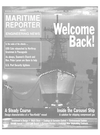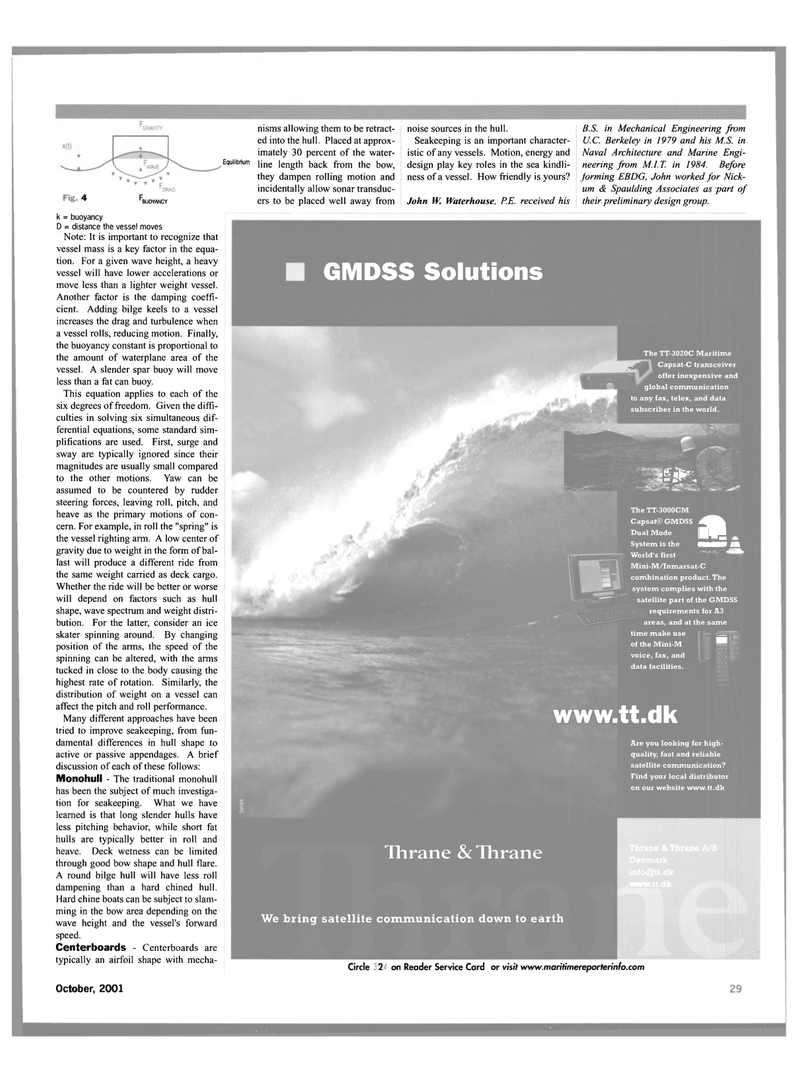
Page 29: of Maritime Reporter Magazine (October 2001)
Read this page in Pdf, Flash or Html5 edition of October 2001 Maritime Reporter Magazine
Equilibrium ^ ^BUOYANCY k = buoyancy
D = distance the vessel moves
Note: It is important to recognize that vessel mass is a key factor in the equa- tion. For a given wave height, a heavy vessel will have lower accelerations or move less than a lighter weight vessel.
Another factor is the damping coeffi- cient. Adding bilge keels to a vessel increases the drag and turbulence when a vessel rolls, reducing motion. Finally, the buoyancy constant is proportional to the amount of waterplane area of the vessel. A slender spar buoy will move less than a fat can buoy.
This equation applies to each of the six degrees of freedom. Given the diffi- culties in solving six simultaneous dif- ferential equations, some standard sim- plifications are used. First, surge and sway are typically ignored since their magnitudes are usually small compared to the other motions. Yaw can be assumed to be countered by rudder steering forces, leaving roll, pitch, and heave as the primary motions of con- cern. For example, in roll the "spring" is the vessel righting arm. A low center of gravity due to weight in the form of bal- last will produce a different ride from the same weight carried as deck cargo.
Whether the ride will be better or worse will depend on factors such as hull shape, wave spectrum and weight distri- bution. For the latter, consider an ice skater spinning around. By changing position of the arms, the speed of the spinning can be altered, with the arms tucked in close to the body causing the highest rate of rotation. Similarly, the distribution of weight on a vessel can affect the pitch and roll performance.
Many different approaches have been tried to improve seakeeping, from fun- damental differences in hull shape to active or passive appendages. A brief discussion of each of these follows:
Monohull - The traditional monohull has been the subject of much investiga- tion for seakeeping. What we have learned is that long slender hulls have less pitching behavior, while short fat hulls are typically better in roll and heave. Deck wetness can be limited through good bow shape and hull flare.
A round bilge hull will have less roll dampening than a hard chined hull.
Hard chine boats can be subject to slam- ming in the bow area depending on the wave height and the vessel's forward speed.
Centerboards - Centerboards are typically an airfoil shape with mecha- nisms allowing them to be retract- ed into the hull. Placed at approx- imately 30 percent of the water- line length back from the bow, they dampen rolling motion and incidentally allow sonar transduc- ers to be placed well away from noise sources in the hull.
Seakeeping is an important character- istic of any vessels. Motion, energy and design play key roles in the sea kindli- ness of a vessel. How friendly is yours?
John W. Waterhouse, P.E. received his
B.S. in Mechanical Engineering from
U.C. Berkeley in 1979 and his M.S. in
Naval Architecture and Marine Engi- neering from M.I.T. in 1984. Before f orming EBDG, John worked for Nick- um & Spaulding Associates as part of their preliminary design group.
GMDSS Solutions
The TT-3020C Maritime ^fr Capsat-C transceiver offer inexpensive and global communication to any fax, telex, and data subscriber in the world.
SjK-
The TT-3000CM
Capsat® GMDSS Jjj^^
Dual Mode j j^H
System is the *
World s first
Mini-M/Inmarsat-C combination product. The system complies with the satellite part of the GMDSS requirements for A3 areas, and at the same time make use _ of the Mini-M voice, fax, and data facilities. www.tt.dk
Are you looking for high- quality, fast and reliable satellite communication?
Find your local distributor on our website www.tt.dk
Thrane &Thrane Thrane & Thrane A/S Denmark [email protected] www.tt.dk
We bring satellite communication down to earth
Circle 280 on Reader Service Card or visit www.maritimereporterinfo.com
October, 2001 44E

 28
28

 30
30
